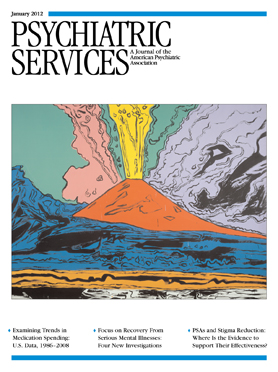News Briefs
CDC reports antidepressant use at 11%: About one of every ten Americans over age 12 takes an antidepressant, according to a report from the Centers for Disease Control and Prevention (CDC). Antidepressants were the third most common prescription drug taken by Americans of all ages in 2005–2008 and the most frequently used by persons age 18 to 44. From 1988–1994 to 2005–2008, the rate of antidepressant use among all age groups increased nearly 400%. Women age 40 to 59 were the most likely to report antidepressant use; 23% of women in this age group reported current use. No differences were found between income groups. More than 60% of those taking an antidepressant reported having taken it for at least two years, and 14% reported ten or more years of use. About one-third of persons with severe depressive symptoms reported current use. Less than one-third of survey respondents taking one antidepressant and less than one-half of those taking multiple antidepressants reported a visit to a mental health professional in the past year. Data are from the National Health and Nutrition Examination Surveys, 2005–2008. Other findings are reported in a data brief available at www.cdc.gov/nchs/data/databriefs/db76.htm.
One in five U.S. adults uses a psychotropic medication: An analysis of trends in psychotropic medication use from 2001 to 2010 among 2.5 million privately insured Americans indicates a substantial increase. In 2010 more than 20% reported current use of at least one such drug, up 22% since 2001. More than a quarter of the adult female population reported current psychotropic use, compared with 15% of men. Women age 45 and older reported the highest use. However, the greatest increase was found among younger men (age 20 to 44); the rate of use in this age group rose 43% from 2001 to 2010. Among adults in 2010, women age 20 to 44 had the highest rate of use of drugs to treat attention-deficit hyperactivity disorder; the proportion of use in this group has increased 264% since 2001. The analysis was conducted by Medco Health Solutions, Inc., a pharmacy benefit manager, which operates the largest U.S. mail order pharmacy. Data were from a stratified random sample of a cohort from Medco's deidentified database of persons with 24 months of continuous drug coverage and eligibility (12 months in the year of interest and 12 months in the prior year). Findings reflect the prevalence of prescription drug use in a commercially insured, primarily private-sector population with stable coverage and employment. Data are presented in an eight-page report, America's State of Mind, available at www.medco.com.
Little evidence for effectiveness of nondrug strategies for treatment-resistant depression: A research review by the Agency for Healthcare Research and Quality has found insufficient evidence to evaluate whether nonpharmacologic approaches are effective for treatment-resistant depression. The review summarizes evidence from 64 studies of varying quality and design on the effectiveness of four nonpharmacologic treatments for treatment-resistant depression—approaches that have been shown to be effective for many patients with depression. The treatments are electroconvulsive therapy, repetitive transcranial magnetic stimulation, vagus nerve stimulation, and cognitive-behavioral therapy or interpersonal psychotherapy. The reviewers conclude that such treatment is “early in its infancy [and] • the most urgent next steps for research are to apply a consistent definition [of treatment-resistant depression and] to conduct more head-to-head clinical trials comparing nonpharmacologic interventions with themselves and with pharmacologic treatments.” The 825-page report, Nonpharmacologic Interventions for Treatment-Resistant Depression in Adults, is available at www.effectivehealthcare.ahrq.gov.
Kaiser Commission report on the “Money Follows the Person” grant program: The health care reform law extended through 2016 the Money Follows the Person (MFP) demonstration grant program. Since 2006 the program has provided states with enhanced federal matching funds for 12 months for each Medicaid beneficiary transitioned from an institutional to a community-based setting. In August 2011 the Kaiser Commission on Medicaid and the Uninsured surveyed states about the current status of the program. A total of 43 states and the District of Columbia have received federal funds under the program. As of August 2011, a total of 16,638 persons had been transitioned since the program's inception, up from a total of 8,902 reported in the 2010 survey and just 349 in the 2008 survey. In addition to seniors, MFP participants include persons with physical and developmental disabilities and mental illness. On average participants are 50 years old. The average transition, primarily to an apartment setting, took about four-and-a-half months, and the overall reinstitutionalization rate was 8.3%. The report notes that after a slow start, 2011 was a turning point for the program. Twelve new grantee states plan to begin operations in 2012. The 14-page report describes challenges that delayed the program from reaching its original goal of 38,000 persons transitioned to the community. The report is available on the Kaiser Family Foundation Web site at www.kff.org/medicaid/8 142.cfm.
Treatment admissions for abuse of prescription pain relievers rise dramatically: The most current available data show that although the overall rate of substance abuse treatment admissions of persons age 12 and older remained nearly the same from 1999 to 2009, the rate of admissions for abuse of prescription pain relievers rose by 430%. Admissions for these drugs increased from ten per 100,000 in the population in 1999 to 53 in 2009. In 2009 admissions for the treatment of primary alcohol abuse were 14% lower, 314 per 100,000 population, compared with 364 in 1999. In 46 of the 50 reporting states and jurisdictions, the admission rate for primary alcohol abuse was higher than that for illicit drug abuse. Admissions for methamphetamine-amphetamine abuse soared between 1999 and 2005 from 32 to 69 per 100,000 population and then dropped annually to 44 per 100,000 in 2009. The 163-page report, Treatment Episode Data Set (TEDS) 1999 to 2009, State Admissions to Substance Abuse Treatment Services, is based on data from thousands of substance abuse treatment facilities in the United States and Puerto Rico. It is available on the Substance Abuse and Mental Health Services Administration Web site at wwwdasis.samhsa.gov.



